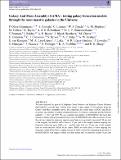Galaxy And Mass Assembly (GAMA) : testing galaxy formation models through the most massive galaxies in the Universe
Abstract
We have analysed the growth of Brightest Group Galaxies and Brightest Cluster Galaxies (BGGs/BCGs) over the last 3 billion years using a large sample of 883 galaxies from the Galaxy And Mass Assembly survey. By comparing the stellar mass of BGGs and BCGs in groups and clusters of similar dynamical masses, we find no significant growth between redshift z = 0.27 and 0.09. We also examine the number of BGGs/BCGs that have line emission, finding that approximately 65 per cent of BGGs/BCGs show H alpha in emission. From the galaxies where the necessary spectroscopic lines were accurately recovered (54 per cent of the sample), we find that half of this (i.e. 27 per cent of the sample) harbour ongoing star formation with rates up to 10 M⊙ yr−1, and the other half (i.e. 27 per cent of the sample) have an active nucleus (AGN) at the centre. BGGs are more likely to have ongoing star formation, while BCGs show a higher fraction of AGN activity. By examining the position of the BGGs/BCGs with respect to their host dark matter halo, we find that around 13 per cent of them do not lie at the centre of the dark matter halo. This could be an indicator of recent cluster-cluster mergers. We conclude that BGGs and BCGs acquired their stellar mass rapidly at higher redshifts as predicted by semi-analytic models, mildly slowing down at low redshifts.
Citation
Oliva-Altamirano , P , Brough , S , Lidman , C , Couch , W J , Hopkins , A M , Colless , M , Taylor , E , Robotham , A S G , Gunawardhana , M L P , Ponman , T , Baldry , I , Bauer , A E , Bland-Hawthorn , J , Cluver , M , Cameron , E , Conselice , C J , Driver , S , Edge , A C , Graham , A W , van Kampen , E , Lara-Lopez , M A , Liske , J , Lopez-Sanchez , A R , Loveday , J , Mahajan , S , Peacock , J , Phillipps , S , Pimbblet , K A & Sharp , R G 2014 , ' Galaxy And Mass Assembly (GAMA) : testing galaxy formation models through the most massive galaxies in the Universe ' , Monthly Notices of the Royal Astronomical Society , vol. 440 , no. 1 , pp. 762-775 . https://doi.org/10.1093/mnras/stu277
Publication
Monthly Notices of the Royal Astronomical Society
Status
Peer reviewed
ISSN
0035-8711Type
Journal article
Collections
Items in the St Andrews Research Repository are protected by copyright, with all rights reserved, unless otherwise indicated.
Related items
Showing items related by title, author, creator and subject.
-
SDSS-IV MaNGA: How the stellar populations of passive central galaxies depend on stellar and halo mass
Oyarzún, Grecco A.; Bundy, Kevin; Westfall, Kyle B.; Tinker, Jeremy L.; Belfiore, Francesco; Argudo-Fernández, Maria; Zheng, Zheng; Conroy, Charlie; Masters, Karen L.; Wake, David; Law, David R.; McDermid, Richard M.; Aragón-Salamanca, Alfonso; Parikh, Taniya; Yan, Renbin; Bershady, Matthew; Sánchez, Sebastián F.; Andrews, Brett H.; Fernández-Trincado, José G.; Lane, Richard R.; Bizyaev, D.; Boardman, Nicholas Fraser; Lacerna, Ivan; Brownstein, J. R.; Drory, Niv; Zhang, Kai (2022-07-06) - Journal articleWe analyze spatially resolved and co-added SDSS-IV MaNGA spectra with signal-to-noise ratio ∼100 from 2200 passive central galaxies (z ∼ 0.05) to understand how central galaxy assembly depends on stellar mass (M*) and halo ... -
Secular-and merger-built bulges in barred galaxies
Mendez Abreu, Jairo; Debattista, V. P.; Corsini, E. M.; Aguerri, J. A. L. (2014-12) - Journal articleContext. Historically, galaxy bulges were thought to be single-component objects at the center of galaxies. However, this picture is now questioned since different bulge types with different formation paths, namely classical ... -
Galaxy And Mass Assembly (GAMA) : galaxy close pairs, mergers and the future fate of stellar mass
Robotham, A. S. G.; Driver, S. P.; Davies, L. J. M.; Hopkins, A. M.; Baldry, I. K.; Agius, N. K.; Bauer, A. E.; Bland-Hawthorn, J.; Brough, S.; Brown, M. J. I.; Cluver, M.; De Propris, R.; Drinkwater, M. J.; Holwerda, B. W.; Kelvin, L. S.; Lara-Lopez, M. A.; Liske, J.; Lopez-Sanchez, A. R.; Loveday, J.; Mahajan, S.; McNaught-Roberts, T.; Moffett, A.; Norberg, P.; Obreschkow, D.; Owers, M. S.; Penny, S. J.; Pimbblet, K.; Prescott, M.; Taylor, E. N.; van Kampen, E.; Wilkins, S. M. (2014-11-11) - Journal articleWe use a highly complete subset of the Galaxy And Mass Assembly II (GAMA-II) redshift sample to fully describe the stellar mass dependence of close pairs and mergers between 10(8) and 10(12)M(circle dot). Using the analytic ...

